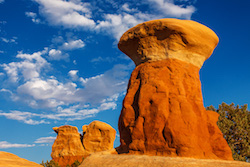SEJournal Online is the digital news magazine of the Society of Environmental Journalists. Learn more about SEJournal Online, including submission, subscription and advertising information.
TipSheet: Trump’s Interior May Be Studying a Monument Near You
When President Donald Trump ordered the Interior Department to study two decades worth of national Monument designations April 26, he opened up a can of political worms. Wherever you live, especially in the West, it may affect public lands (and environmental politics) near you.
During the last year or two of his administration, former President Barack Obama made liberal use of the 1906 Antiquities Act to set land aside and protect it from extraction and development. While most conservation set-asides of federal land require some Congressional action, the Antiquities Act authorizes the president to create national monuments simply by decree.
The Antiquities Act can sometimes save a tract of land from imminent devastation, giving Congress time to absorb it into some other conservation program later. So it was with the Grand Canyon.
Some western states and politicians have resented Obama’s use of the authority. Their aggressive agenda on public lands includes not just undoing Obama’s actions, but privatizing other federal land or giving it to the states. It’s an old political tradition (remember the Sagebrush Rebellion?)
So many westerners cheered when Trump launched a bid to possibly undo Obama’s monument declarations — and those of other presidents. The executive order tells Interior Secretary Ryan Zinke to “review” any national monument created since Jan. 1, 1996, that is larger than 100,000 acres.
 |
| Devil's Garden at Grand Staircase-Escalante National Monument in Escalante, Utah, which is at risk of losing its federally protected status under President Trump's recent order. Photo: James Marvin Phelps, Flickr Creative Commons. |
Fuzzy language in the order itself creates some question about just what monument designations are covered. The Interior secretary can include smaller monuments if he thinks they were created without adequate public consultation.
Many reporters will want the list of monuments. But different outlets have come up with different lists.
The Washington Post says it covers about 25 monuments. Men’s Journal put the number at 57. USA TODAY names some 24 actually listed by the White House. The Los Angeles Times has a nice pictorial list. At a briefing, Zinke said the review would cover “24 to 40.” Over the years since 1906, Wikipedia lists 129 designations in all.
One thing we know: Bears Ears Monument in Utah is on the list, since the order mentions it by name — its designation was controversial.
During the transition, conservationists were mildly heartened when Zinke said he would never give away public lands. But many conservationists worry that the monuments review would allow the administration to take millions of acres out of conservation status. Before Trump’s announcement, Zinke gave a press briefing, the transcript of which is here.
One of the factors at play in monument politics are the interest groups:
- Ranchers and drillers often take a dim view of conservation status for federal lands — since it may deny them the ability to make money from the land.
- Native American and indigenous groups often have a strong feeling about preserving the lands.
- The outdoor recreation industry contributes a huge dollar boost to the U.S. economy, and it has tended to support monuments. Patagonia has even threatened to sue the Trump administration over monuments.
- In the case of the vast marine national monuments in the Pacific, opponents even include the fishing industry.
By the way, the uses of public lands also have serious consequences for climate change.
For a conservationist viewpoint, try the Sierra Club, the Wilderness Society or the Center for Biological Diversity. For less enthusiasm for monument designations, try the American Lands Council, the Western Governors’ Association or the Public Lands Council.
* From the weekly news magazine SEJournal Online, Vol. 2, No. 18. Content from each new issue of SEJournal Online is available to the public via the SEJournal Online main page. Subscribe to the e-newsletter here. And see past issues of the SEJournal archived here.













 Advertisement
Advertisement 



